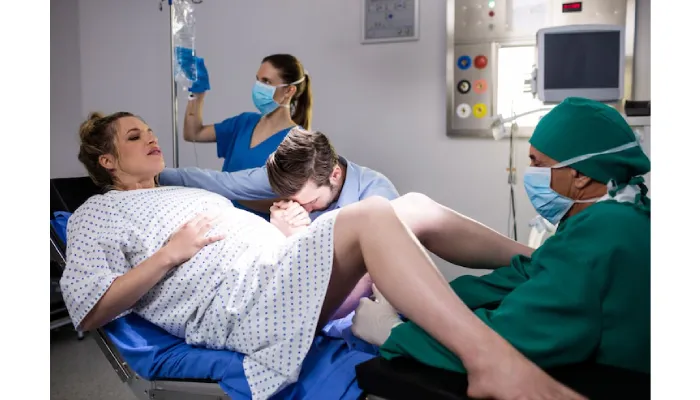Preparing for fertility tests in San Diego means understanding the timing and types of tests involved. Most female tests, like ovarian reserve evaluation and hysterosalpingogram (HSG), are scheduled early in the menstrual cycle, usually between days 6 to 11. For procedures like saline infusion sonohysterography (SIS), patients should follow pre-test instructions carefully, including taking prescribed antibiotics and avoiding ovulation periods. Male partners need to abstain from ejaculation for a few days before providing semen samples. It’s helpful to bring medical records and discuss any allergies or medications with your doctor. Clinics in San Diego often offer personalized care and support, including virtual consultations to prepare you fully for testing.
Fertility Testing Process in San Diego
San Diego Fertility Center is tailored to each individual’s health history and needs, ensuring a personalized approach. Typically, women complete most of their testing within one menstrual cycle to provide timely and accurate results. Both partners usually undergo evaluation to cover all possible fertility factors. The process may include blood work, ultrasounds, X-rays like hysterosalpingograms, and semen analysis depending on what the specialist recommends. Scheduling appointments often depends on timing within the menstrual cycle to optimize the accuracy of results. Initial consultations help patients understand the testing plan and address any questions, while the clinic reviews medical history, medications, and previous tests beforehand. Many San Diego clinics offer multilingual support to assist a diverse patient base, providing clear instructions for preparation specific to each test. After testing, follow-up visits are important to discuss results and decide on the next steps in fertility care, ensuring patients feel supported throughout the process.
Preparing for Ovarian Reserve Evaluation
To prepare for an ovarian reserve evaluation in San Diego, schedule your blood tests early in your menstrual cycle, typically between days 2 and 5. These tests include measuring Anti-Müllerian Hormone (AMH) levels, which provide insight into your egg quantity and quality. Along with blood work, a transvaginal ultrasound is performed to count antral follicles that range from 2 to 9 millimeters, giving a clear picture of your ovarian reserve. Avoid scheduling these tests during or right after ovulation to ensure the most accurate results. It’s important to inform your doctor about any hormone medications you’re taking, as they can affect test outcomes. Follow any fasting or timing instructions provided by your clinic for blood draws. For the ultrasound, wear comfortable clothing since the procedure involves a vaginal probe. Make sure to notify your provider if you have any pelvic pain or recent infections before the ultrasound. If you have previous test results, bring them along so your doctor can track changes over time. The information gathered from these tests plays a crucial role in planning your fertility treatment and deciding the best timing for interventions.
What to Expect During a Hysterosalpingogram (HSG)?
A hysterosalpingogram, or HSG, is an X-ray test that uses a special dye to check the shape of the uterine cavity and to see if the fallopian tubes are open. This test is usually scheduled between day 6 and day 11 of your menstrual cycle to avoid interfering with an early pregnancy and to get the clearest results. When you arrive, you will lie down on an exam table while a speculum is gently inserted into the vagina to reach the cervix. Then, a thin catheter is placed into the cervix to slowly inject the contrast dye. As the dye moves through the uterus and fallopian tubes, fluoroscopy, a real-time X-ray, monitors the flow to identify any blockages or abnormalities. Many patients feel some cramping or mild discomfort during the dye injection, but this usually lasts only a short time. It is important to notify your clinic ahead of time if you have any allergies to iodine or contrast materials, as this can affect the procedure. Your clinic staff will provide clear instructions before your appointment, which may include taking antibiotics to reduce the risk of infection. After the test, it’s common to experience mild spotting and some cramping; resting for the remainder of the day is recommended to help with recovery. Avoid scheduling the HSG close to menstruation or ovulation to ensure the best quality images and accurate results.
Steps to Get Ready for Saline Infusion Sonohysterography (SIS)
Saline Infusion Sonohysterography (SIS) is typically scheduled after your menstrual period ends but before ovulation, usually in the first half of your cycle. This timing helps ensure the best imaging of the uterine lining. Your physician may prescribe antibiotics before the test to lower the risk of infection, so be sure to follow these instructions carefully. It’s important to inform the clinic about any allergies you have, especially to iodine or seafood, as this can affect preparation and safety.
On the day of the procedure, avoid scheduling SIS during ovulation or late in your cycle to get the clearest results. During the test, a speculum is inserted into the vagina to clean the cervix, and a thin catheter delivers sterile saline into the uterus. At the same time, a vaginal ultrasound probe is used to visualize the uterine lining clearly. The entire procedure usually takes less than 15 minutes and is done on an outpatient basis.
After SIS, you might experience mild cramping or light spotting. It is recommended to rest lying down for 5 to 10 minutes immediately after the test to help ease any discomfort. While risks are low, including infection, fainting, or allergic reactions, you should contact your doctor right away if you notice symptoms such as fever, heavy bleeding, or increasing pain. Compared to other tests like Hysterosalpingogram (HSG), SIS is generally less painful and better tolerated by most patients.
Guidelines for Semen Analysis Preparation
To prepare for a semen analysis in San Diego, the male partner should abstain from ejaculation for 2 to 5 days before collecting the sample. This ensures the sperm count and quality are accurately assessed. It’s important to follow the clinic’s instructions about where to collect the sample; some clinics allow collection at home, but the sample must be delivered promptly to the lab. The entire sample should be collected in a sterile container provided by the clinic. Avoid alcohol, exposure to excessive heat (like hot tubs or saunas), and certain medications before the test, as these can affect sperm quality. After collection, keep the sample close to body temperature, for example by carrying it in a pocket, and bring it to the clinic within the recommended timeframe, usually within an hour. Discuss any recent illnesses, medications, or concerns about sample collection with your fertility specialist beforehand to help interpret results properly. If there are difficulties in providing the sample, notify the lab staff, they can offer guidance or reschedule if needed. The semen analysis evaluates sperm count, shape, and movement to assess fertility. If results are abnormal or inconsistent, repeat testing may be advised to confirm findings. Providing a full medical history related to reproductive health can assist the lab and specialist in understanding the results more thoroughly.
General Tips for Scheduling and Preparing Fertility Tests
Tracking your menstrual cycle carefully is key to scheduling fertility tests during the ideal time frames, such as early in the cycle for ovarian reserve tests or between days 6 and 11 for procedures like HSG. Bringing all relevant medical records, previous test results, and insurance information to your appointments helps the fertility team provide personalized care without delays. It’s important to openly discuss any current medications, allergies, or health conditions with your provider before testing to avoid complications or inaccurate results. Follow any specific pre-test instructions closely, such as fasting requirements or taking prescribed antibiotics before certain procedures like saline infusion sonohysterography. Wearing comfortable clothing can make blood draws and pelvic ultrasounds easier, especially if you expect to be there for a while. Plan for mild discomfort during or after some tests and consider arranging rest time afterward, particularly if sedation or pain medication may be involved, confirm your transportation options in advance. Don’t hesitate to ask clinic staff about how long each procedure will take and what sensations to expect, so you feel more prepared and less anxious. Coordinating test days around your work or personal schedule can reduce stress and help you focus on the process. Keep emergency contact information handy in case you experience any unusual symptoms following testing. These steps can help you feel more confident and comfortable throughout your fertility testing journey in San Diego.
- Track menstrual cycles carefully to schedule tests within optimal timing windows.
- Bring all relevant medical records, previous test results, and insurance information to appointments.
- Discuss all current medications, allergies, and health conditions with the fertility team before testing.
- Follow specific pre-test instructions such as fasting, antibiotic use, or timing restrictions.
- Wear comfortable clothes suitable for blood draws and pelvic ultrasounds.
- Plan for possible mild discomfort during or after tests; arrange for rest time if needed.
- Ask clinic staff about expected procedure duration and what to expect during tests.
- Coordinate with work or personal schedules to avoid stress on test days.
- Keep emergency contact information handy in case of unexpected symptoms after testing.
- Confirm transportation arrangements especially if sedation or pain medication is involved.
Support and Services Offered by San Diego Fertility Clinics
San Diego fertility clinics provide a wide range of support services aimed at making the testing process smoother and less stressful. Many clinics offer free initial consultations where patients can learn about testing options, ask questions, and get personalized guidance before any procedures begin. To accommodate diverse communities, multilingual services are available in languages such as French, Spanish, German, Italian, and Chinese. Emotional support is also a key component, with counseling services designed to help patients manage the anxiety and emotional challenges that often come with fertility testing. Clinics frequently offer fertility wellness guidance that covers important lifestyle factors like nutrition, exercise, and stress management, which can impact fertility results. Understanding the financial side can be overwhelming, so insurance and financing counselors assist patients in navigating coverage details and payment options. For convenience, virtual consultations are an option, allowing patients to prepare remotely and reduce the need for in-person visits. Out-of-town patients benefit from coordinated care with local doctors, ensuring continuity and ease when traveling to San Diego for testing. Educational materials are provided in clear, simple language to help patients understand procedures and test results without confusion. Dedicated staff maintain ongoing communication about appointments and follow-up, keeping patients informed every step of the way. Additionally, some clinics encourage joining support groups or patient networks, offering community and shared experiences that can be comforting during this journey.
Managing Discomfort and Reporting Post-Test Symptoms
It’s normal to experience mild cramping or light spotting after fertility tests like HSG or SIS, and these symptoms typically go away quickly. After your procedure, take the time to rest for 5 to 10 minutes if your clinic staff suggests it. Over-the-counter pain relievers can help ease any discomfort, but be sure to use only those recommended by your doctor. Avoid heavy lifting and strenuous activities on the day of your test and for at least 24 hours afterward to give your body time to recover. Stay hydrated and eat light meals before and after testing to support your wellbeing. Follow all aftercare instructions carefully, including taking any prescribed antibiotics to reduce the risk of infection. If you notice more serious symptoms such as fever, heavy bleeding, severe pain, rash, dizziness, fainting, or signs of an allergic reaction, contact your healthcare provider immediately. Keeping a symptom diary can be useful if discomfort persists, helping your doctor understand your experience better. Don’t hesitate to ask your clinic about emergency contacts and after-hours support options to feel more secure during your recovery period.
Planning Fertility Testing When Visiting San Diego
When planning fertility testing in San Diego, it’s important to schedule your appointments well in advance to align with your menstrual cycle. Timing is key for accurate results, especially for tests like ovarian reserve evaluation and hysterosalpingogram. If possible, coordinate with your local healthcare provider to complete any preliminary tests before traveling, which can save time and streamline your visit. Make sure to bring all your medical records, prior test results, and insurance information to each appointment to help your fertility specialist build a clear picture of your history. If your testing requires multiple visits, plan for travel and accommodations accordingly, and check with the clinic about transportation options and how accessible the location is. Many clinics in San Diego offer language support and patient services, so ask about these to ensure comfortable communication. Initial consultations often take extra time to thoroughly discuss your testing plan, so prepare your questions ahead of time to make the most of your visit. Virtual consultations are also available at many clinics, which can reduce the number of in-person visits and help clarify what to expect. Finally, understand the clinic’s protocols for any follow-up testing or treatments after your visit, so you can plan your schedule and next steps with confidence.
How to Use Medical Records and Insurance for Testing?
Bringing all relevant medical documents, including previous fertility tests and treatments, is essential when preparing for fertility testing in San Diego. Sharing a complete list of medications and any allergies with your fertility specialist helps ensure safe and effective care. Before scheduling tests, verify with your insurance provider which fertility procedures are covered, and if needed, obtain referrals or prior authorizations to avoid delays. Keeping copies of all test results and clinical notes allows you to track your progress and share information easily with other doctors. Many clinics have staff members who can assist you in understanding billing details, co-pays, and out-of-pocket costs, so don’t hesitate to ask for help. Submitting insurance claims promptly and following up on any denied claims can prevent unexpected expenses. Using your medical records wisely also helps avoid duplicate testing, which can save time and reduce costs. If financial concerns arise, discussing payment plans or financial options with the clinic’s counselors can provide helpful solutions. Finally, maintaining open communication between your primary care doctor and fertility clinic supports coordinated care, ensuring everyone involved is informed and your treatment moves forward smoothly.

Mary Burns is a dedicated writer focusing on health and fitness topics. With a passion for promoting wellness and vitality, Mary shares her knowledge and expertise through engaging and informative blog posts.




